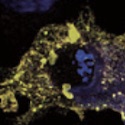 Kelch-like Protein 11 Seminoma-associated Paraneoplastic Encephalitis
Kelch-like Protein 11 Seminoma-associated Paraneoplastic EncephalitisCaleigh Mandel-Brehm, Ph.D., Divyanshu Dubey, M.D., Thomas J. Kryzer, A.S., Brian D. O’Donovan, Ph.D., Baouyen Tran, Ph.D., Sara E. Vazquez, B.S., Hannah A. Sample, B.S., Kelsey C. Zorn, M.H.S., Lillian M. Khan, B.S., Ian O. Bledsoe, M.D., Andrew McKeon, M.D., Samuel J. Pleasure, M.D., Ph.D., Vanda A. Lennon, M.D., Ph.D., Joseph L. DeRisi, Ph.D., Michael R. Wilson, M.D., and Sean J. Pittock, M.D.
NEJM 2019Abstract: A 37-year-old man with a history of seminoma presented with vertigo, ataxia, and diplopia. An autoantibody specific for kelch-like protein 11 (KLHL11) was identi- fied with the use of programmable phage display. Immunoassays were used to identify KLHL11 IgG in 12 other men with similar neurologic features and testicular disease. Immunostaining of the patient’s IgG on mouse brain tissue showed sparse but distinctive points of staining in multiple brain regions, with enrichment in perivascular and perimeningeal tissues. The onset of the neurologic syndrome preceded the diagnosis of seminoma in 9 of the 13 patients. An age-adjusted esti- mate of the prevalence of autoimmune KLHL11 encephalitis in Olmsted County, Minnesota, was 2.79 cases per 100,000 men.
